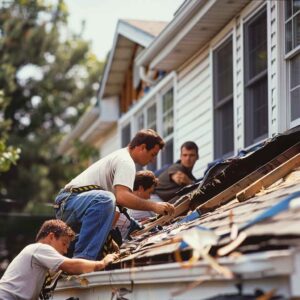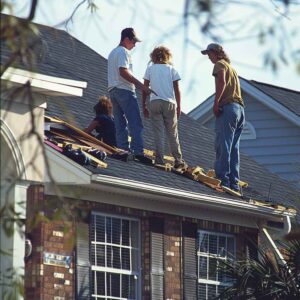Are you looking for sustainable roofing options? You’re in luck! Numerous environmentally conscious options exist to assist you in conserving energy and diminishing your carbon footprint.
Opting for any of these sustainable alternatives allows you to make a positive environmental impact while experiencing the advantages of a resilient and efficient roof.
Solar Panels
If you are considering sustainable roofing options, one option to explore is installing solar panels. Utilizing solar panels presents an excellent means to harness solar power and decrease dependence on conventional energy sources.
One crucial factor to consider when choosing solar panels is their efficiency. Solar panel efficiency refers to how well the panels can convert sunlight into usable energy.
Look for panels with high-efficiency ratings to maximize the amount of energy you can generate.
Additionally, it’s essential to understand the solar panel installation process. It typically involves evaluating your roof’s suitability, mounting the panels, and connecting them to your home’s electrical system.
It is advisable to enlist the services of professional roofers in Gap, PA to guarantee a secure and effective installation.
Green Roofs
To continue exploring sustainable roofing options, let’s delve into the benefits of incorporating green roofs onto your roof.
Green roofs are a fantastic way to make your roof more environmentally friendly and add beauty to your home.
Here are four reasons why you should consider installing a green roof:
1. Urban farming: Green roofs provide an opportunity for urban farming, allowing you to grow vegetables, herbs, and flowers on your roof. This promotes self-sufficiency and reduces the need for transportation of produce.
2. Biodiversity enhancement: Green roofs create habitat for birds, bees, and other pollinators, fostering biodiversity in urban areas. This helps to restore the balance of ecosystems and support local wildlife.
3. Energy efficiency: Green roofs provide natural insulation, reducing your home’s need for heating and cooling. This leads to decreased energy consumption and a reduction in greenhouse gas emissions.
4. Stormwater management: Green roofs absorb rainwater, reducing the strain on urban drainage systems and preventing flooding. Functioning as natural filters, they eliminate pollutants and enhance the quality of water runoff.
Cool Roofs
Green roofs provide numerous environmental benefits, but another sustainable roofing option to consider is a cool roof.
Cool roofs are engineered to reflect sunlight and absorb minimal heat compared to conventional roofs, leading to decreased energy consumption and a diminished environmental impact.
Cool roofs help keep buildings cooler by reflecting sunlight, reducing the need for air conditioning and thus saving energy.
Enhanced energy efficiency results in reduced utility bills and diminished greenhouse gas emissions linked to electricity generation.
Additionally, cool roofs can improve the durability and lifespan of the roof by reducing thermal expansion and contraction.
With their energy-saving properties and positive environmental impact, cool roofs are an excellent choice for those looking to make their homes or buildings more sustainable.
Recycled Roofing Materials
One option to continue the discussion when considering sustainable roofing options is using recycled materials for your roof, which can further reduce environmental impact and contribute to a more sustainable building.
Here are four reasons why recycled roofing materials are a great choice:
1. Energy-efficient insulation: Recycled roofing materials often have excellent insulation properties, helping to reduce energy consumption and lower heating and cooling costs.
2. Eco-friendly manufacturing process: Recycled roofing materials are made from repurposed old tires, plastic bottles, or rubber. Using these materials can divert waste from landfills and reduce the need for new resource extraction.
3. Durability and longevity: Recycled roofing materials are designed to be durable and long-lasting, meaning they require less maintenance and replacement over time.
4. Cost-effective: While the initial cost of recycled roofing materials may be slightly higher, the long-term savings in energy bills and maintenance costs can make them a cost-effective choice in the long run.
Rainwater Harvesting Systems
Maximize the sustainability of your roof by implementing a rainwater harvesting system. Rainwater harvesting is one of the most effective water conservation techniques available.
Collecting rainwater from your roof can reduce your reliance on municipal water sources and lower your water bills.
The benefits of rainwater harvesting are numerous:
- It reduces the strain on local water supplies, especially during dry seasons or in areas with limited water resources.
- Rainwater is naturally soft and chemical-free, making it ideal for irrigation or other non-potable uses.
- Rainwater harvesting helps prevent water runoff, which can lead to soil erosion and pollution of nearby water bodies.
Installing a rainwater harvesting system is a practical and sustainable solution for homeowners who want to conserve water and minimize their environmental impact.
Conclusion
Overall, several sustainable roofing options are available that can help contribute to a greener and more environmentally friendly future.
Some solutions can meet different needs and budgets, from solar panels and green roofs to cool roofs and recycled materials.
Additionally, implementing rainwater harvesting systems or foam roofing can further enhance sustainability efforts. By choosing these sustainable roofing options, you can reduce your carbon footprint and save on energy costs in the long





